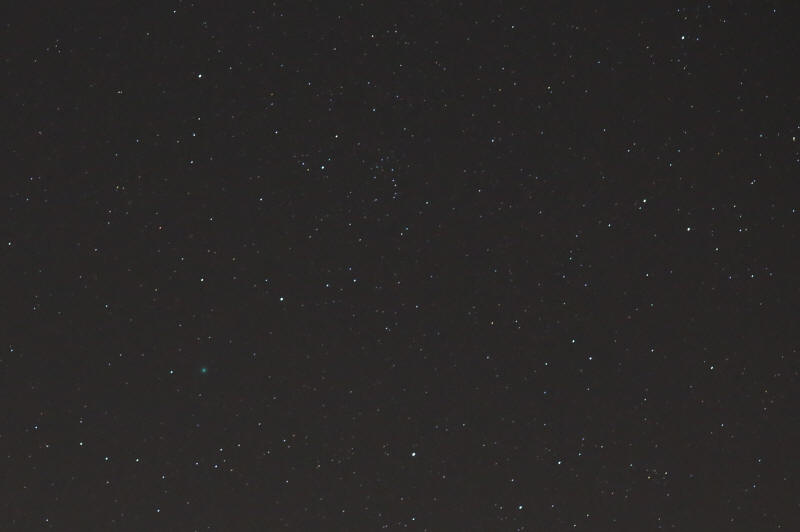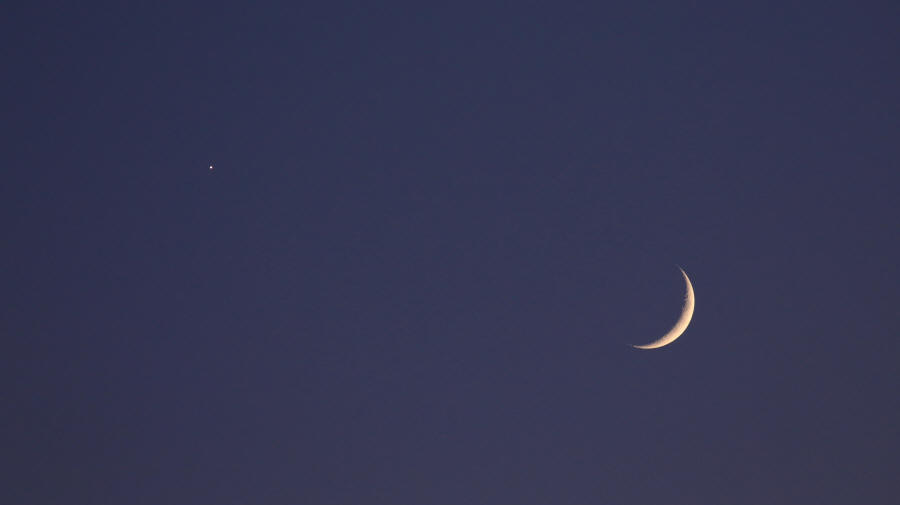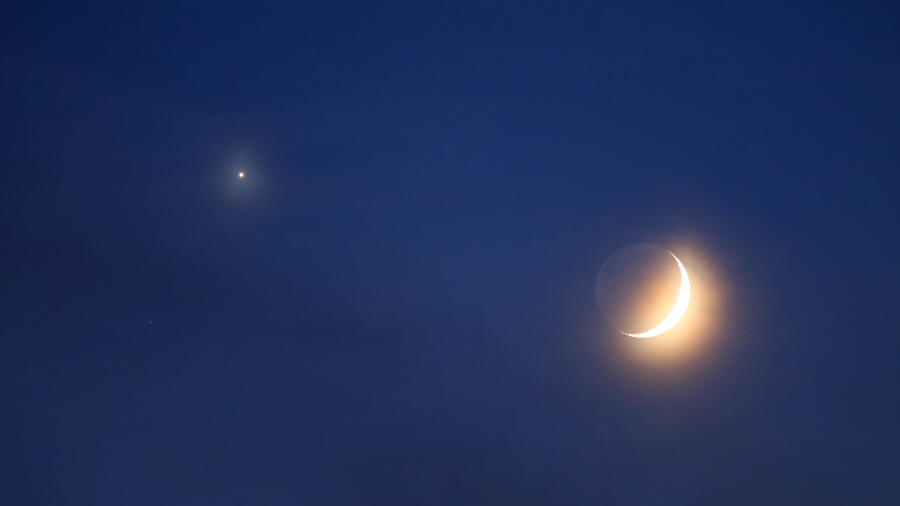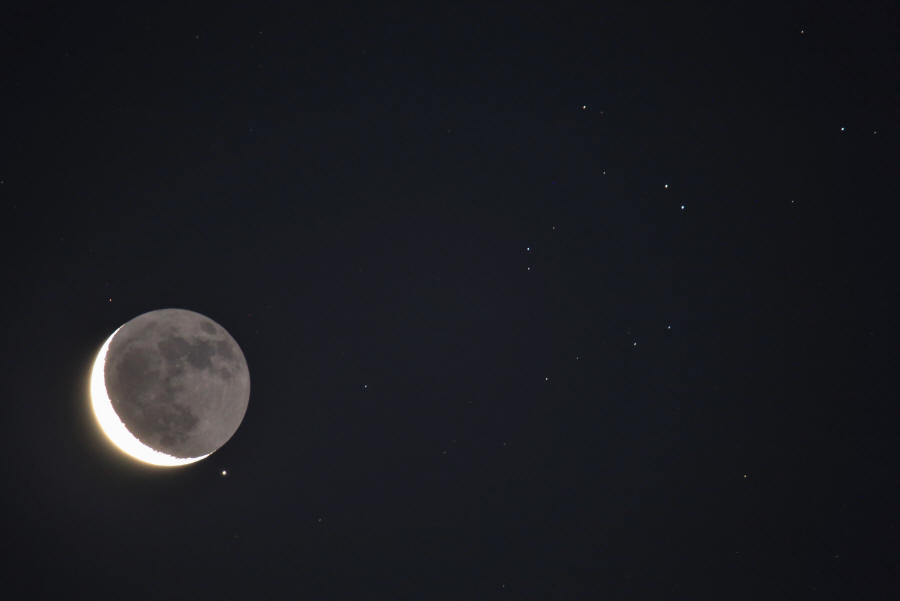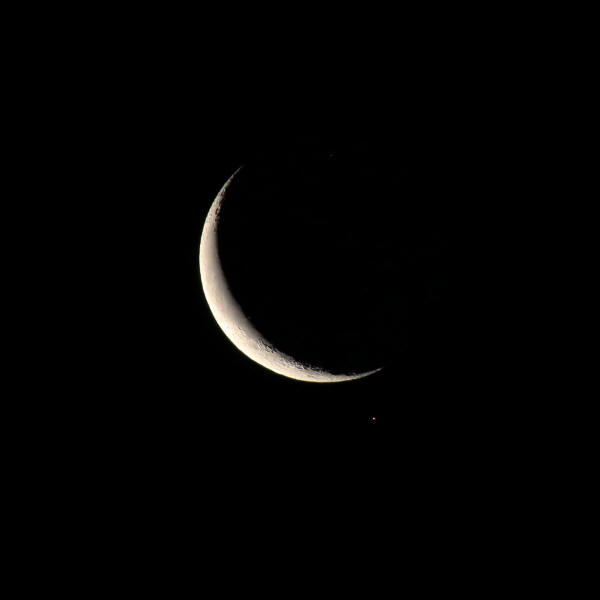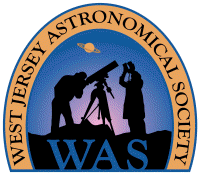SJAstro Page Index
Mars at Perihelic Opposition
I observed
Mars
on
July 27, 2018, between
1:00 and 1:40 am EDT, from my Maple Shade, NJ, backyard with a
Stellarvue 130 mm, f/7 apo refractor, mainly at 253x, using a Stellarvue
Optimus 3.6 mm, 100° eyepiece. In particular, I was viewing Mars (in the
scope plus a glance with unaided eyes) at 1:13 am EDT, the moment of
opposition and the moment when it crossed the meridian for my location,
essentially at 40°N-75°W.
At the time,
Mars was 24.3 arc seconds in apparent diameter and 24.7° altitude,
somewhat low because of its -6.5° ecliptic latitude in southwest
Capricornus.
Due to the global dust storm in progress on Mars
(which may be subsiding slightly), surface detail was sparse. With
patience at the eyepiece, I could make out a small, not-exactly-white
spot representing the South Polar Cap and a slight whitish rim at the
northern limb representing the Northern Polar Hood. There was also a
vague, faint horizontal darkish band across the southern reaches of the
disc, which did not show enough detail to match it to any of the Mars
surface feature charts, although based on the date and time, those
charts indicate it was mainly Mare Sirenum.
Update:
It was pretty hazy on Wednesday night,
August 15, 2018, and Mars
wasn’t the brilliant beacon it’s been recently because of the haze, but
I thought this might afford some decent seeing. So, I decided to get out
my 80 mm, f/6 apo refractor for a quick look from the backyard around
11:30 pm EDT. Transit was at 11:35 pm and Mars was 23.3" apparent
diameter. Using an Explore Scientific 4.7 mm, 82 deg eyepiece yielding
102x and a 48 arc minute true field of view, Mars looked steady (i.e.,
seeing was at least good, if not very good). I used a diagonal, so the
view was correct vertically, reversed left-to-right.
Despite the relatively small aperture and low
magnification, I quickly saw some detail. There was a darkish, inverted
T-shaped feature just left (west) of the central meridian. The
horizontal portion of the “T” was below the equator and below that,
there was a disc-like area that was a bit lighter in color than the rest
of the non-dark surface. Finally, there was a whitish patch along the
bottom limb, a tad left of center. However, its visibility varied with
the momentary seeing, and it periodically showed a dark rim at its upper
edge. I’m not a Martian surface feature expert, but I suspected the
darkish vertical extension was Syrtis Major, the lighter disc was
Hellas, and of course, the South Polar Cap was at the bottom limb.
So, it looks like the obscuring effect of the Martian dust storm is
truly to diminishing. Next time, I’ll get out the 130 mm refractor and
have a better view, before Mars drops below 20 arc seconds diameter
after September 5.
When I opened WinJUPOS for Mars set to the time of
observation and a refractor+diagonal orientation, I was pleasantly
surprised to see a good match with my eyepiece view (see the
WinJUPOS
synthetic image below). It also
corresponded with S&T’s Mars Profiler utility, which confirmed my
suspected identities above. The Mars Profiler indicated Mare Tyrrhenum
and Mare Serpentis formed the darkish horizontal band below Syrtis
Major, perhaps extending to Sinus Sebaeus and Sinus Meridiani (the
"pipe") towards
the east (on the right like the eyepiece view).
This is a WinJUPOS-generated synthetic image of Mars on August 15,
2018, at 11:30 pm EDT, north up, east right (like a refractor+diagonal).
The dashed vertical line is the central meridian, the dashed horizontal
line is the equator. The small red circle is the sub-solar point.
Comet C/2017 S3 (PANSTARRS)
This image shows Comet C/2017 S3 (PANSTARRS), captured on
July 19, 2018, at 2:51 am
EDT from Carranza Field in Wharton State Forest, NJ. The comet is the
small bluish-green spot in the bottom-left quadrant. It is next to the
magnitude 7.4 star, HD 31779 in the constellation
Camelopardalis, near the Auriga-Perseus border. Mouseover for
labels. This comet experienced a couple of
outbursts in July 2018 and is currently significantly brighter than
originally predicted by the standard ephemeris. It was easily seen with
15x56 binoculars on the morning of July 19 at Carranza (under a clear,
dark sky).
The image was taken with a Canon 6D digital SLR camera and a Canon 200
mm f/2.8L telephoto lens (on a fixed tripod). It was exposed 4 seconds
at f/3.5, ISO 6400, 4000K white balance, and then cropped to about 57%
of the original size for a field about 5.9° wide x 3.9° high. Otherwise,
it's unprocessed.
I've also labeled the position where the comet was seen with the 15x56s
on the morning of July 18 from Maple Shade, NJ, although with much more
difficulty under partially cloudy, light-polluted suburban skies.
The Crescent Moon and Venus
The 2.9-day-old, 12.3% illuminated Crescent Moon
was 2.66° from the planet Venus
(center to center) when this image of them was captured at 8:48 pm EDT
on July 15, 2018,
from the baseball field complex in Maple Shade, NJ. This
is a single frame taken with a Canon 6D digital SLR camera
and a Canon 400 mm f/5.6L telephoto lens (on a fixed tripod), then
cropped vertically to a 16:9 ratio for a field about 5.1° wide x 2.9°
high. It was exposed 1/400 second at f/6.3, ISO 3200 and daylight white
balance. Since it was only 21 minutes after sunset, the sky was still
fairly blue. The image below was taken 25 minutes later in a darker sky.
The Crescent Moon
was 2.44° from the planet Venus
(center to center) when this image of them was captured at 9:13 pm EDT
on July 15, 2018,
from the baseball field complex in Maple Shade, NJ. This
is a single frame taken with a Canon 6D digital SLR camera
and a Canon 400 mm f/5.6L telephoto lens (on a fixed tripod), then
cropped vertically to a 16:9 ratio for a field about 5.1° wide x 2.9°
high. It was exposed 1/2 second at f/5.6, ISO 1600 and daylight white
balance. This is an additional 7 stops of exposure compared to the first
image. It was now 46 minutes after sunset, and some blue remained in the
sky. Unfortunately, the sky was also somewhat cloudy and hazy, so the
longer exposure in a darker sky shows glowing halos around them, as well
as earthshine on the Moon. Magnitude +3.9 Rho Leonis is faintly visible
below-left of magnitude -4.1 Venus, which is 8 magnitudes, or 1,600x
brighter than Rho. Mouseover for labels.
Here's a snapshot of the photo setup for these
Moon+Venus images. It was taken with my iPhone 5s at 8:52 pm. Exposed
1/24 second at f/2.2, ISO 320. The Canon 6D camera is attached to a
white Canon 400 mm telephoto lens, the tripod foot of which is attached,
via an Arca-Swiss style plate, to a Acratech GP ball head (in the gimbal
position) on top of a Benro carbon fiber tripod. I use an infrared
remote to trigger the shutter, so there's no cord dangling down. I meant
to move onto the grass after setting up, but I forgot. Mouseover for
labels. I've also indicated the spot where
Mercury was
subsequently spotted with 10x50 binoculars.
The Crescent Moon and Aldebaran
The 26.5-day-old, 11.2% illuminated and earthshine-filled Crescent Moon
was exiting the Hyades star
cluster on July 10, 2018,
when this image of them was captured from Swede Run in Moorestown, NJ, at
4:25 am
EDT, 75 minutes before sunrise, and 2.77 days before the next new moon
on July 12 at 10:48 pm. This
is a single frame taken with a Canon 6D digital SLR camera
and a Tamron 150 to 600 mm f/5-6.3 zoom lens (on a fixed tripod) set to
600 mm focal length, then cropped to 90% of the
original frame, producing a field about 3° wide x 2° high. It was
exposed 0.8 seconds at
f/6.3, ISO 3200, 4200K white balance. The moon passed about 4 arc minutes from the
first-magnitude star Aldebaran, which is just off the southern cusp in
this image (one needed to be farther north to
see an occultation). Mouseover for labels.
The image below is a much-shorter exposure that shows some detail in the
illuminated crescent at the expense of not showing the earthshine.
Aldebaran, below the southern cusp of the Moon, shows a reddish color,
some intrinsic but certainly some red contributed by the atmosphere at
the low altitude, about 9.5° at the time.
This
is a single frame taken at 4:17 am with a Canon 6D digital SLR camera
and a Tamron 150 to 600 mm f/5-6.3 zoom lens (on a fixed tripod) set to
600 mm focal length, then cropped to 38% x 56% of the original frame,
producing a field about 1.3° square. It was exposed 1/125 second at
f/6.3, ISO 3200 (100x less exposure than the previous image at 0.8, or
1/1.25 seconds), 3600K
white balance.
Click here
for the previous page.
Click here
for an index to previous SJAstro pages.
July
27, 2018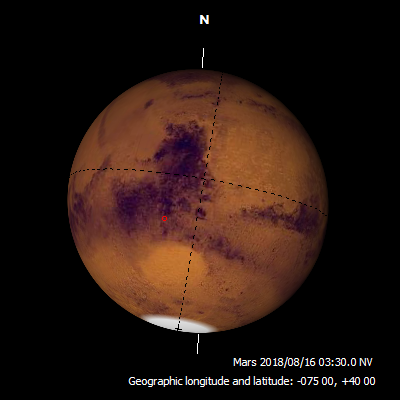
July 19, 2018
July 15, 2018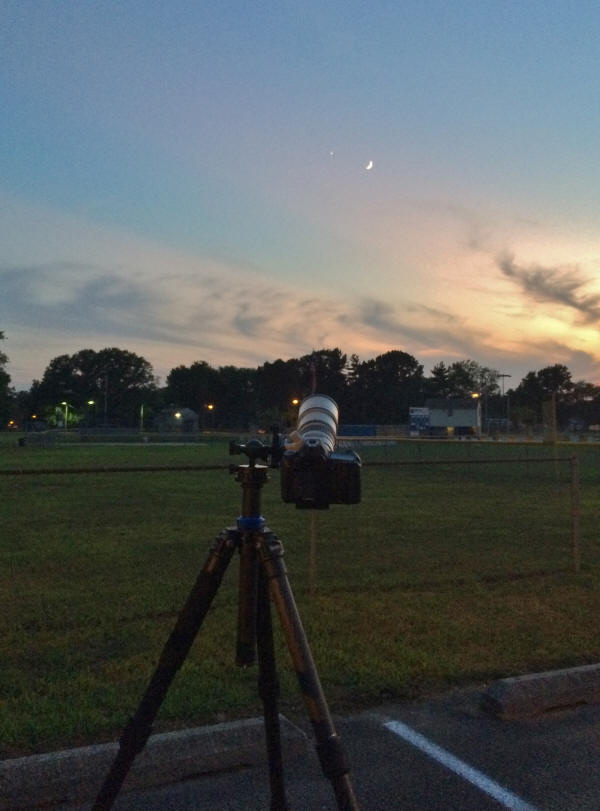
July 10, 2018
